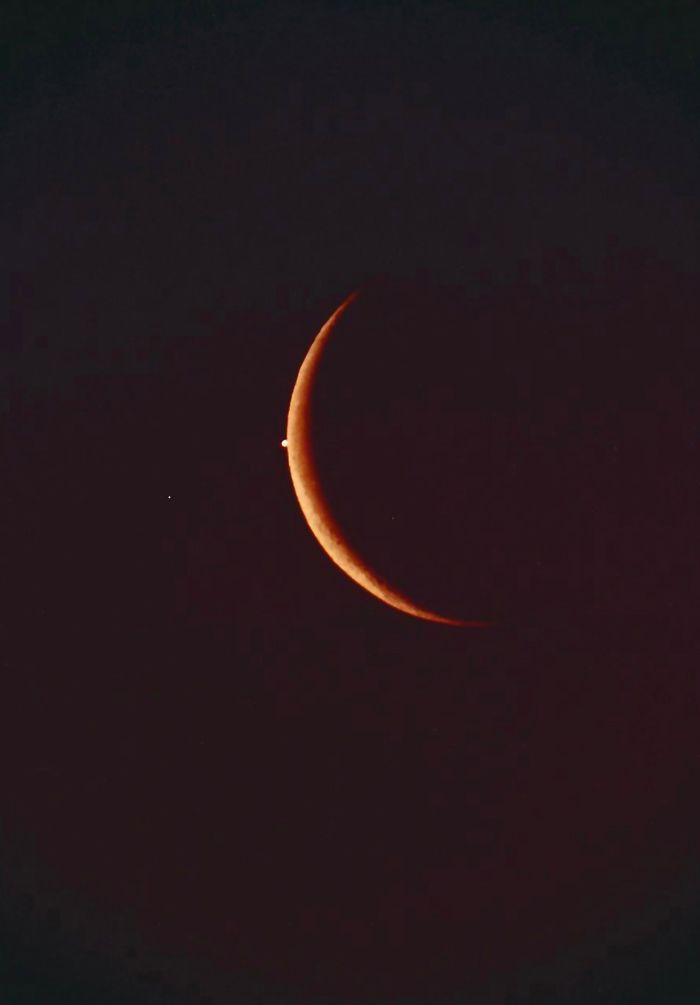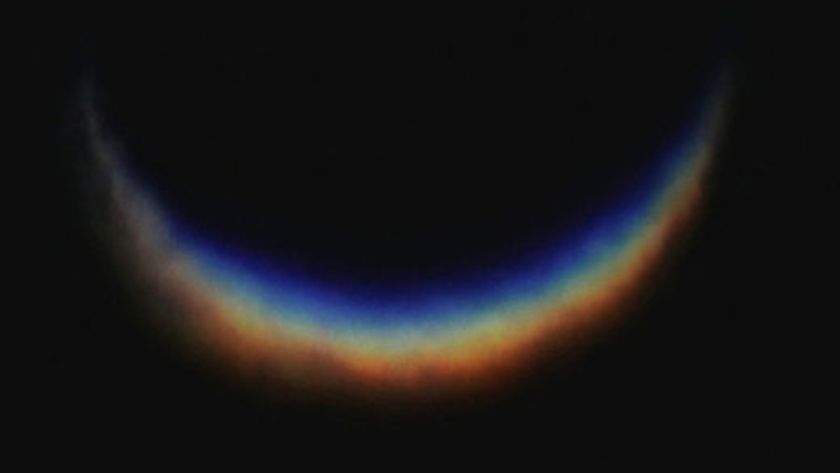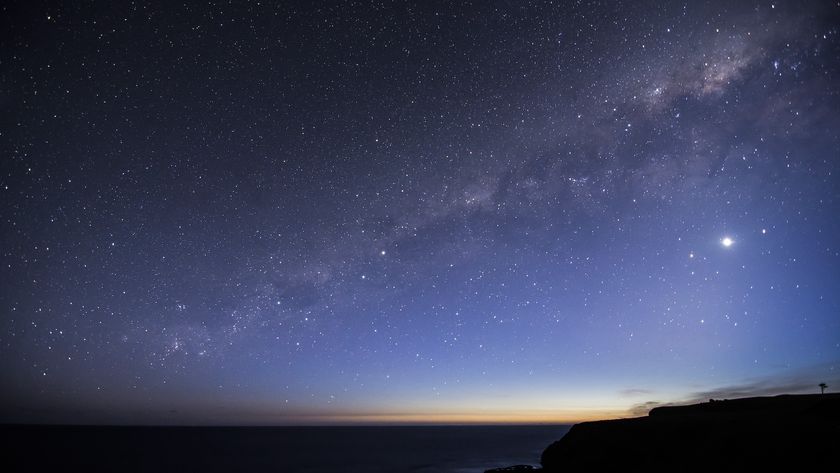
Capturing Venus: An Amateur Astronomer's Famous Moon Shot

Victor Rogus is an amateur astronomer, and this is the second in his series of exclusive Space.com posts about amateur astronomy. He contributed this article to Space.com's Expert Voices: Op-Ed & Insights.
It was April 25, 1987, and I was about to document one of the most impressive events I have had the good fortune to witness — a lunar occultation of the planet Venus . Then shining at magnitude -3.4, Venus would be covered by a waning crescent Moon just before sunrise that morning.
Local weather predicted clear skies for that event, and these objects are quite bright enough to photograph without traveling to a dark-sky site. In another piece of good luck, the occultation would take place on a Saturday morning — good because I didn't have to work.
It would seem that all I would require was an eastern horizon free from obstruction. My plan was to locate an observing site after work on Friday so I would be prepared well in advance. Driving around, I saw a small stand of trees on the western side of a cornfield — the trees would shield me from the stray headlights of passing cars and perhaps hide me from curious onlookers. After all, I would be trespassing in a suburban area of Chicago — Des Plaines, Ill., to be exact. This land was one of the last operating farms in the area (and was later made into a subdivision of town homes).
Now that I knew where I was going, all that remained was to go home and load up my equipment. Returning around midnight would allow me plenty of time to sneak my telescope onto the farmer's land and set it up. Although I do not condone trespassing, sometimes there is simply no one around from whom you can ask permission. Be careful! Always take the time to find the owner of land you wish to use, and obtain permission, this can avoid problems later in the evening when things are getting good. When I photographed this event this back in 1987 I was still a newcomer to the hobby and have learned better!
Midnight arrived, and I set my plan in motion. Parking my small pickup truck in a vacant lot, I began to unload my home-built, 8-inch f/6 Newtonian telescope and its German equatorial mount. The cool air greeted me with a chill. The stars Vega, Arcturus and Spica shimmered in the sleepy suburban sky, keeping me company while I balanced my scope and polar-aligned its mount.
Then, after a bit, there was not much to do but go talk to that policeman who was signaling me with his flashlight.
Sign up for the Live Science daily newsletter now
Get the world’s most fascinating discoveries delivered straight to your inbox.
"Hello, hello!" I called, holding my hands out in a friendly, non-hostile manner.
"So what are you up to?" he asked, just a bit sarcastically.
"I'm here to try to photograph an occultation of the planet Venus. It should … "
"Oh, you are just here to look at the stars," he interrupted.
"Yes, yes, I have my telescope set up over there by those trees."
"OK, no problem. I saw your van parked in that lot and wanted to make sure there were no knuckle-heads out here causing trouble."
"No sir, no knuckle heads, no trouble, but thanks for checking on me," I responded with a smile.

"Have fun," he said and closed the door of his squad car. He sat there for a little while and then drove off.
This scene I would live out many times in the years to follow. The police have shown up at quite a few of my stargazing sessions, and never once have they made me move on or given me a hard time in any way. In fact, after they see what I'm doing, we sometimes share a couple of laughs and I occasionally offer them a look at Jupiter or Saturn through my telescope. From my experience, I have seen law enforcement out there at all hours of the night when most of us are home snug in bed. They work keeping us safe from knuckleheads, while we often take them for granted, and they have my highest respect.
The evening wore on. It was starting to feel late, and there was no sign of Venus or the moon. The predawn sky was starting to show just a hint of blue. Could I have been in error? Was this not the morning of the occultation? Knowing the event would only be visible from certain parts of the United States, my doubts began to grow. As the eastern sky gradually brightened, the slender crescent of the moon and the brilliant beacon of Venus rose nearly simultaneously. There, in majestic conjunction, with less than one-half degree of separation, the splendid objects drew closer in cosmic attraction with a grace that only nature could accomplish. I had to go to work.
It is said that photographers always miss something during events like this. While the pure observer can savor every moment of such a spectacle, the photographer has the responsibility (if only to himself) of documenting it. He often fiddles with cameras or other equipment instead of enjoying the event.
My camera was loaded with 400-asa (ISO) Kodak Ektachrome slide film. My telescope's primary mirror was set for F 6 prime focus astrophotography. After focusing, I began to bracket exposures. I stood in awe as the moon and the brightest planet in the solar system climbed higher and still nearer to one another in the pre-dawn sky.
The beauty of the scene before me was so dramatic and so fleeting that I wanted to wake up the people who dozed in the little suburban houses scattered all around the empty cornfield and alert them to this wondrous sight. There would be no time for this, though, so I stood-alone.
Now with Venus only arc-seconds from the Moon, the speed at which the event was proceeding surprised me. I continued to bracket exposures: 1/4 second, 1/2 second, 1 second, 3 seconds, 5 seconds and repeat. The sky was becoming quite bright, and I could see the epoxy-white optical tube of my telescope quite easily. Objects on the ground once obscured by the darkness of night started to come into plain view, and birds began to sing. Now, the moment I had waited for arrived. Venus, the planet named for the goddess of love, appeared to touch Luna, the Earth's moon. Repeatedly, I made exposures, praying that I had captured the moment on film. Then, brilliant Venus instantly vanished from view, and I gasped, "My God!"
A moment later, the sun rose, joining the moon and its hidden companion. It would be some time before Venus re-emerged from behind the lunar dark limb, and the sun was climbing rapidly. There would be no option but to call it a night and pack it all in. That celestial event remains to this day one of my most memorable.
Space.com is hosting a slideshow of Rogus's images.
The views expressed are those of the author and do not necessarily reflect the views of the publisher. This version of the article was originally published on Space.com.












